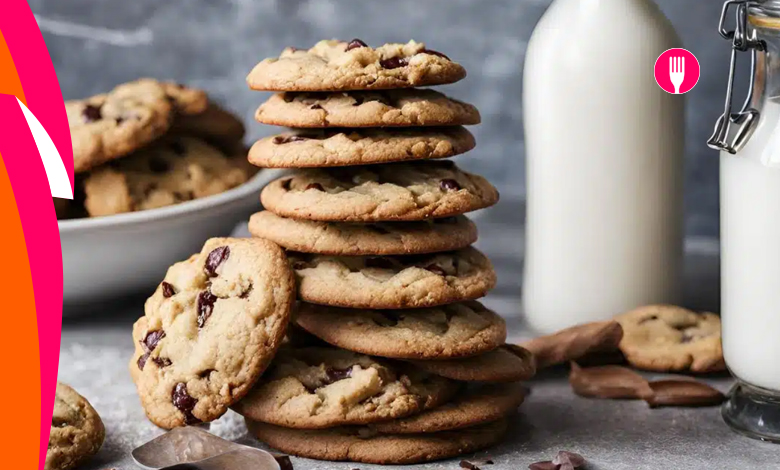Unlocking the Secrets: Maintaining Soft Cookies Perfection

ADVERTISEMENT
If you’re a cookie enthusiast, you understand the joy of sinking your teeth into a warm, freshly baked treat. Yet, the disappointment kicks in when the remaining batch loses its softness over time. Fear not! Unraveling the secrets to maintaining that delectable softness is easier than you think. Discover the tricks that will keep your cookies irresistibly soft long after they emerge from the oven.
Locking in Moisture: The Airtight Solution
Moisture plays a crucial role in preserving the softness of your cookies. When exposed to air, cookies quickly lose moisture, resulting in a dry, crumbly texture. The solution? Store your cookies in an airtight container. This simple step locks in moisture, ensuring your cookies remain soft and chewy. For an extra safeguard, toss in a slice of bread to absorb excess moisture and prevent your cookies from becoming overly moist.
Decoding the Science of Soft Cookies Baking

Baking cookies is a precise science demanding attention to detail. Understanding the intricate dance between wet and dry ingredients is paramount for maintaining that desired soft texture.
Check This : Christmas Maraschino Cherry Shortbread Cookies Recipe
The Ingredient Ratio Ballet
The ratio of wet to dry ingredients can make or break your cookie’s texture. Too much flour yields dry and crumbly cookies, while excess liquid results in a flat, greasy outcome. Achieving the perfect balance requires accurate measurement and adherence to the recipe.
Time and Temperature Choreography
Baking time and temperature are critical factors influencing cookie texture. Overbaking leads to hardness, while underbaking results in a doughy center. Vigilance is key—monitor time and temperature closely, adjusting as needed for that ideal texture.
Flour Varieties: Choosing Your Dance Partner
The type of flour chosen also impacts cookie texture. While all-purpose flour is standard, opting for bread flour creates a chewier outcome, while cake flour produces a softer cookie. Selecting the right flour is pivotal for achieving your desired texture.
Crafting the Perfect Cookie: Ingredient Edition
Elevate your soft and chewy cookie game by carefully selecting the right ingredients. The choices you make can significantly influence the outcome.
Flour Power: Selecting the Ideal Type
The type of flour you choose can shape your cookie’s texture. All-purpose flour is a solid choice for soft and chewy cookies due to its medium protein content. For an even softer result, experiment with cake flour, boasting a lower protein content for a delicate and tender cookie.
ADVERTISEMENT
Sweet Symphony: Mastering Sugar Selection
Sugar isn’t just for sweetness—it also contributes to cookie moisture. Opt for brown sugar, richer in moisture than its white counterpart. For the perfect balance, blend both brown and white sugar in your recipe.
Fat Matters: Butter vs. Alternatives
The fat used influences cookie texture. Butter, with its water and air pockets, is a top pick for soft and chewy cookies. To enhance softness further, consider using shortening or oil, which contain more fat for an extra tender cookie.
Baking Ballet: Techniques for Soft Perfection

Your baking techniques are the choreography for achieving soft and chewy cookies. Pay attention to the following nuances for an impeccable result.
The Dance of Time and Temperature
Avoid the pitfalls of overbaking or underbaking. Following the recommended time and temperature in your recipe is crucial. Invest in an oven thermometer to ensure accuracy, as different ovens may have varying temperatures.
Size and Shape: The Balletic Dimensions
Cookie size and shape impact their softness. Larger, thicker cookies tend to retain more moisture, resulting in a softer, chewier outcome. Experiment with dimensions to find your perfect cookie texture.
Post-Baking Elegance: Ensuring Prolonged Softness
The softness journey continues after the cookies leave the oven. Proper cooling and storage are key components.
Cool Graduation
Allow your cookies to cool adequately. Leave them on the baking sheet briefly before transferring to a wire rack. This prevents breakage or excessive dryness.
Storage Symphony
After cooling, adopt effective storage methods to maintain softness:
- Airtight Container: Seal in freshness by storing cookies in an airtight container, preventing staleness. Add a piece of bread to absorb excess moisture.
- Plastic Wrap: Preserve individual cookies with plastic wrap, ideal for freezing.
- Freezer Bag: When freezing, use a freezer bag, removing as much air as possible to prevent freezer burn.
By following these post-baking tips, you’ll extend the lifespan of your soft and chewy cookies.
Navigating the Cookie Pitfalls: Mistakes to Sidestep
Several common mistakes can turn your cookies from soft to hard. Avoid these pitfalls for consistently delightful results.
The Culprit of Over-Baking
Over-baking ranks as a major culprit for hard and crunchy cookies. Adhere to recommended baking times and temperatures. Use a timer, checking periodically, or employ a thermometer for precision.
Ingredient Measurement Harmony
Incorrect ingredient measurements, especially with flour, lead to dry cookies. Use a kitchen scale for accurate results or employ the spoon-and-level method for precise flour measurement.
Mixing Mastery
The art of mixing impacts cookie texture. Ensure ingredients are just combined; over-mixing yields toughness, while under-mixing results in thin, crispy cookies.
By sidestepping these common mistakes, your cookies will consistently emerge soft and chewy.
In Summation: The Softness Finale
In conclusion, maintaining softness in baked cookies is an art that requires diligence. From storage practices and ingredient choices to precise baking techniques, each element plays a role. Embrace an airtight container, choose the right ingredients, dance gracefully with baking techniques, and follow post-baking rituals for enduring softness. Every cookie recipe is a unique journey, so experiment, learn, and enjoy consistently soft and delicious cookies.
Frequently Asked Questions (FAQs)
Q: What are some tips for keeping cookies soft after baking?
A: To keep cookies soft, add a slice of bread to the storage container or use an airtight container to prevent them from drying out.
Q: How do you store cookies to keep them soft?
A: Place cookies in an airtight container, adding a slice of bread to maintain moisture. Store in a cool, dry place away from direct sunlight and heat sources.
Q: Are there any ingredients that can help keep cookies soft?
A: Yes, honey, corn syrup, and molasses can help retain moisture, ensuring soft and chewy cookies.
Q: Can cookies be softened after they’ve already hardened?
A: Yes, place cookies in a container with a slice of bread or a damp paper towel. Alternatively, microwave them for a few seconds in a container with a damp paper towel.
Q: Can cookies be frozen to maintain their softness?
A: Yes, store cookies in an airtight container or freezer bag. Thaw at room temperature for a few hours before serving.
Q: How can you tell if a cookie will be soft or crunchy before baking?
A: Ingredients and baking time/temperature determine texture. More butter and sugar result in softer cookies, while less leads to a crispier outcome. Adjust baking time and temperature accordingly.
ADVERTISEMENT